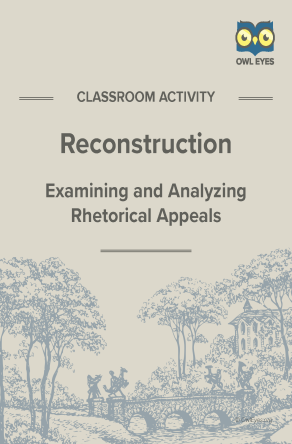Reconstruction Rhetorical Appeals Activity
- 11 pages
- Subject: Ethos, Logos, Pathos, Rhetorical Devices, Lesson Plans and Educational Resources
- Common Core Standards: RI.11-12.3, RI.11-12.5, RI.11-12.6, RI.11-12.9, RI.9-10.3, RI.9-10.5, RI.9-10.6, RI.9-10.9
Additional Reconstruction Resources
Product Description
In his 1866 essay “Reconstruction,” Frederick Douglass uses his rhetorical skill to instill a sense of urgency into his readership in order to persuade Congress to take quick, decisive legislative action. Former Confederate states had enacted “black codes” and President Andrew Johnson had both instituted his own Reconstruction plans without the advice of Congress and vetoed key bills for civil rights. However, at the end of 1866, much still needed to be done to counteract the damage of the early Reconstruction policies that appeased Southern interests. Douglass frequently refers to historical events to add credibility to his claims while appealing to shared sympathies through the use of accessible and often metaphorical language—all to illustrate the dangers looming in the nation and the need for progressive change.
Skills: analysis, close reading, drawing inferences from text, examining the impact of diction on audience
About This Document
The Owl Eyes Rhetorical Appeals activity gives students an opportunity to practice examining and analyzing the Aristotelian rhetorical appeals: ethos, pathos, and logos. Students will analyze selected rhetorical appeals from the text to determine which appeal they best represent and explain the appeal’s impact. The main components include the following:
- A brief introduction to the text
- A detailed handout on rhetorical appeals
- A list of tips for spotting rhetorical appeals
- A step-by-step guide to activity procedure
- A detailed answer key for teachers
In completing this worksheet, students will be able to examine and analyze Aristotle’s three rhetorical appeals in order to evaluate works of rhetoric and the techniques they employ.







